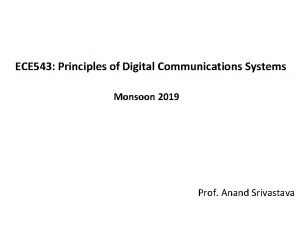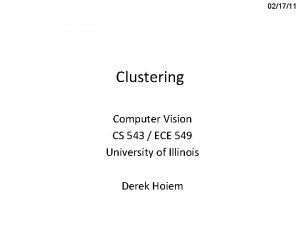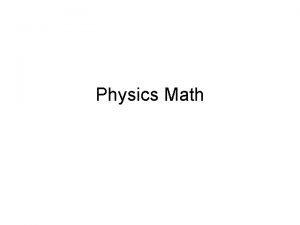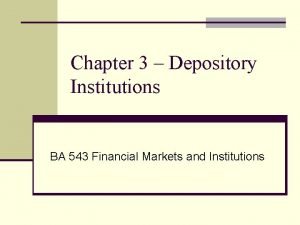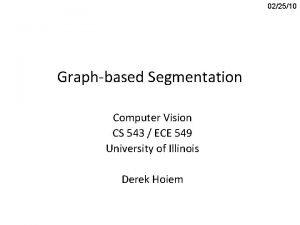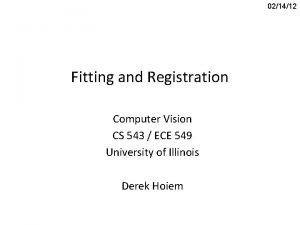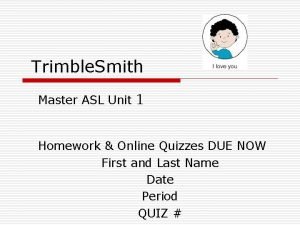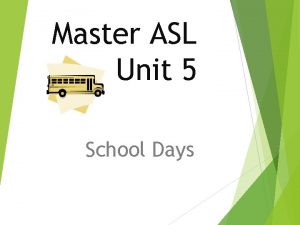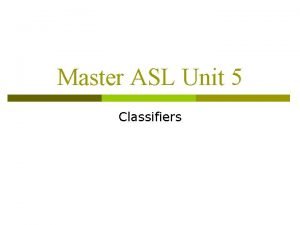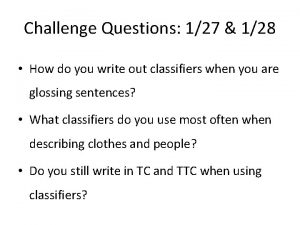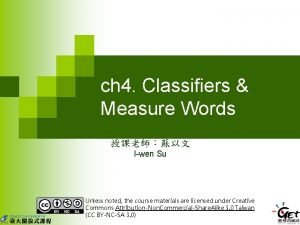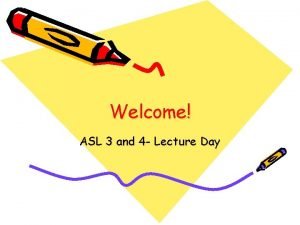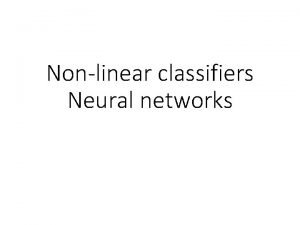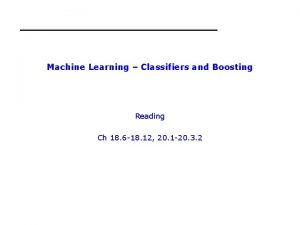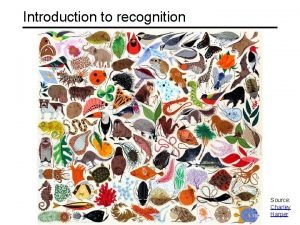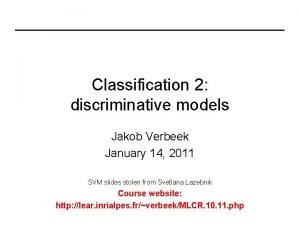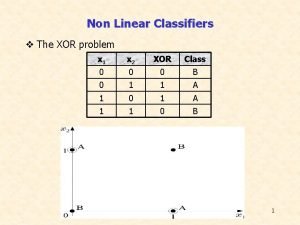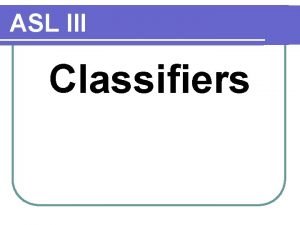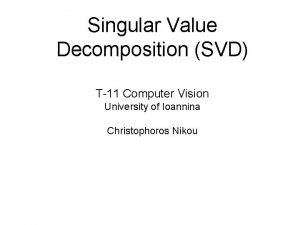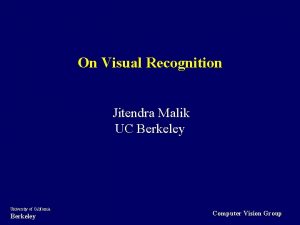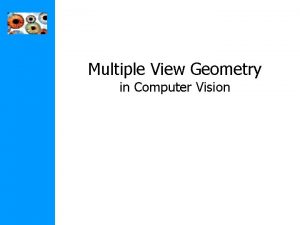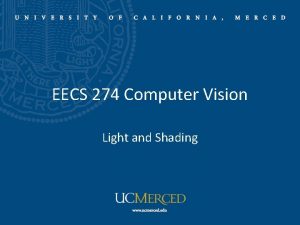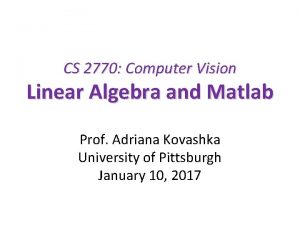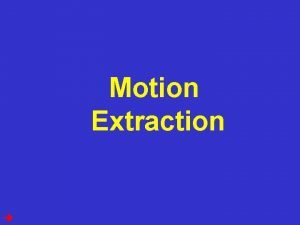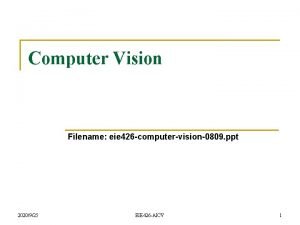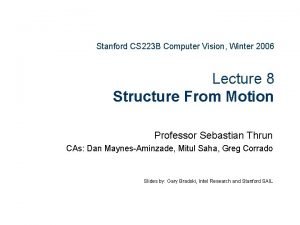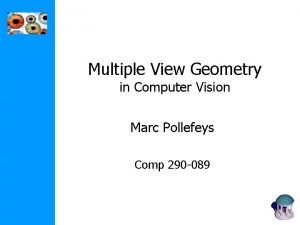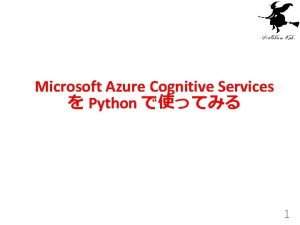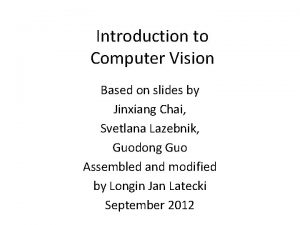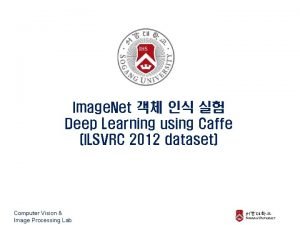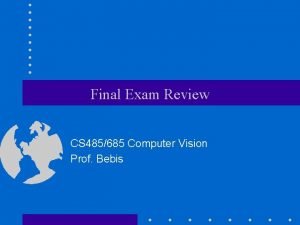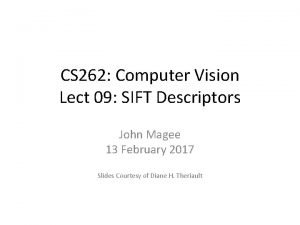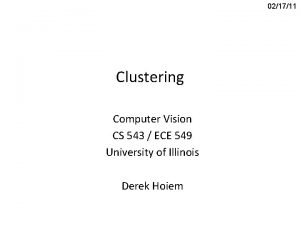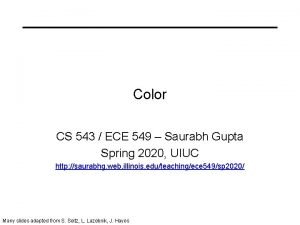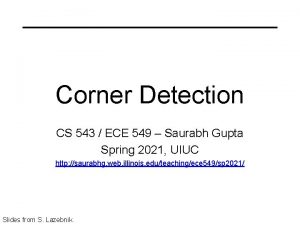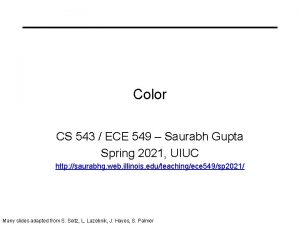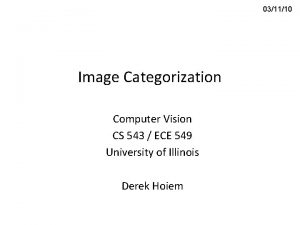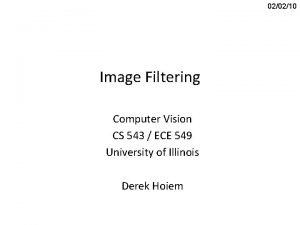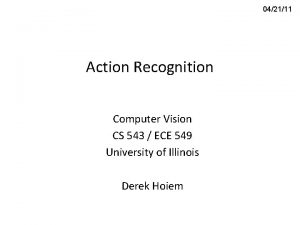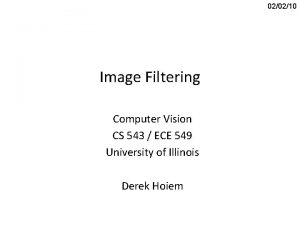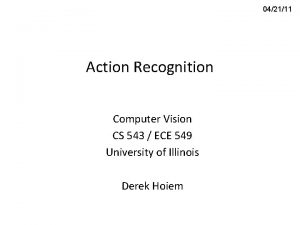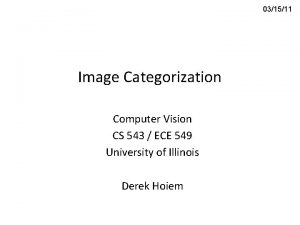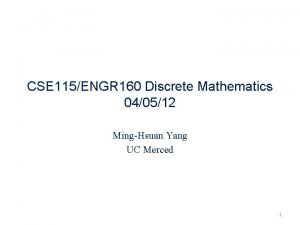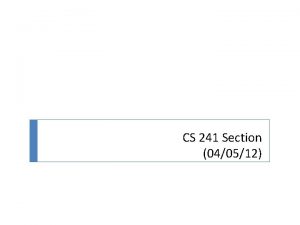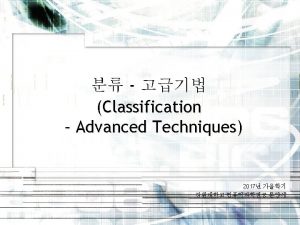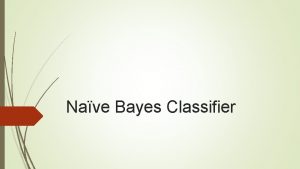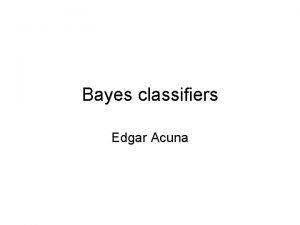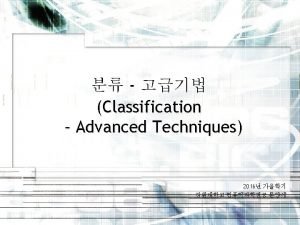040512 Classifiers Computer Vision CS 543 ECE 549
















































- Slides: 48

04/05/12 Classifiers Computer Vision CS 543 / ECE 549 University of Illinois Derek Hoiem

Today’s class • Review of image categorization • Classification – A few examples of classifiers: nearest neighbor, generative classifiers, logistic regression, SVM – Important concepts in machine learning – Practical tips

• What is a category? • Why would we want to put an image in one? To predict, describe, interact. To organize. • Many different ways to categorize

Examples of Categorization in Vision • Part or object detection – E. g. , for each window: face or non-face? • Scene categorization – Indoor vs. outdoor, urban, forest, kitchen, etc. • Action recognition – Picking up vs. sitting down vs. standing … • Emotion recognition • Region classification – Label pixels into different object/surface categories • Boundary classification – Boundary vs. non-boundary • Etc, etc.

Image Categorization Training Images Image Features Training Labels Classifier Training Trained Classifier

Image Categorization Training Images Image Features Training Labels Classifier Training Trained Classifier Testing Image Features Test Image Trained Classifier Prediction Outdoor

Feature design is paramount • Most features can be thought of as templates, histograms (counts), or combinations • Think about the right features for the problem – Coverage – Concision – Directness

Classifier A classifier maps from the feature space to a label x x o x x x o o o x 2 x 1 o x x x

Different types of classification • Exemplar-based: transfer category labels from examples with most similar features – What similarity function? What parameters? • Linear classifier: confidence in positive label is a weighted sum of features – What are the weights? • Non-linear classifier: predictions based on more complex function of features – What form does the classifier take? Parameters? • Generative classifier: assign to the label that best explains the features (makes features most likely) – What is the probability function and its parameters? Note: You can always fully design the classifier by hand, but usually this is too difficult. Typical solution: learn from training examples.

One way to think about it… • Training labels dictate that two examples are the same or different, in some sense • Features and distance measures define visual similarity • Goal of training is to learn feature weights or distance measures so that visual similarity predicts label similarity • We want the simplest function that is confidently correct

Exemplar-based Models • Transfer the label(s) of the most similar training examples

K-nearest neighbor classifier x x o x + o o x 2 x 1 x o+ x x x

1 -nearest neighbor x x o x + o o x 2 x 1 x o+ x x x

3 -nearest neighbor x x o x + o o x 2 x 1 x o+ x x x

5 -nearest neighbor x x o x + o o x 2 x 1 x o+ x x x

K-nearest neighbor x x o x + o o x 2 x 1 x o+ x x x

Using K-NN • Simple, a good one to try first • Higher K gives smoother functions • No training time (unless you want to learn a distance function) • With infinite examples, 1 -NN provably has error that is at most twice Bayes optimal error

Discriminative classifiers Learn a simple function of the input features that confidently predicts the true labels on the training set Goals 1. Accurate classification of training data 2. Correct classifications are confident 3. Classification function is simple

Classifiers: Logistic Regression • • • Objective Parameterization Regularization Training Inference x x o x x x o o o x x x o x 2 x 1 The objective function of most discriminative classifiers includes a loss term and a regularization term.

Using Logistic Regression • Quick, simple classifier (try it first) • Use L 2 or L 1 regularization – L 1 does feature selection and is robust to irrelevant features but slower to train

Classifiers: Linear SVM x x o x o o o x 2 x 1 x o x x x

Classifiers: Kernelized SVM x x o oo x x x o x 2 x x x o o

Using SVMs • Good general purpose classifier – Generalization depends on margin, so works well with many weak features – No feature selection – Usually requires some parameter tuning • Choosing kernel – Linear: fast training/testing – start here – RBF: related to neural networks, nearest neighbor – Chi-squared, histogram intersection: good for histograms (but slower, esp. chi-squared) – Can learn a kernel function

Classifiers: Decision Trees x x o x o o x 2 x 1 x o x x x

Ensemble Methods: Boosting figure from Friedman et al. 2000

Boosted Decision Trees High in Image? Yes No Smooth? Yes Gray? Yes Green? No Yes No High in Image? … Yes Many Long Lines? No Yes No Very High Vanishing Point? Blue? Yes No No Ground Vertical Sky Yes No P(label | good segment, data) [Collins et al. 2002]

Using Boosted Decision Trees • Flexible: can deal with both continuous and categorical variables • How to control bias/variance trade-off – Size of trees – Number of trees • Boosting trees often works best with a small number of well-designed features • Boosting “stubs” can give a fast classifier

Generative classifiers • Model the joint probability of the features and the labels – Allows direct control of independence assumptions – Can incorporate priors – Often simple to train (depending on the model) • Examples – Naïve Bayes – Mixture of Gaussians for each class

Naïve Bayes • • • Objective Parameterization Regularization Training Inference y x 1 x 2 x 3

Using Naïve Bayes • Simple thing to try for categorical data • Very fast to train/test

Clustering (unsupervised) + + + + x o + + x + o + x 2 x 1 o o x 2 x 1 x x x

Many classifiers to choose from • • • SVM Neural networks Naïve Bayesian network Logistic regression Randomized Forests Boosted Decision Trees K-nearest neighbor RBMs Etc. Which is the best one?

No Free Lunch Theorem

Generalization Theory • It’s not enough to do well on the training set: we want to also make good predictions for new examples

Bias-Variance Trade-off E(MSE) = noise 2 + bias 2 + variance Unavoidable error Error due to incorrect assumptions Error due to variance parameter estimates from training samples See the following for explanations of bias-variance (also Bishop’s “Neural Networks” book): • http: //www. stat. cmu. edu/~larry/=stat 707/notes 3. pdf • http: //www. inf. ed. ac. uk/teaching/courses/mlsc/Notes/Lecture 4/Bias. Variance. pdf

Bias and Variance Error = noise 2 + bias 2 + variance Test Error Few training examples High Bias Low Variance Many training examples Complexity Low Bias High Variance

Choosing the trade-off • Need validation set • Validation set is separate from the test set Error Test error Training error High Bias Low Variance Complexity Low Bias High Variance

Effect of Training Size Error Fixed classifier Testing Generalization Error Training Number of Training Examples

How to measure complexity? • VC dimension What is the VC dimension of a linear classifier for Ndimensional features? For a nearest neighbor classifier? Upper bound on generalization error Test error <= Training error + N: size of training set h: VC dimension : 1 -probability that bound holds • Other ways: number of parameters, etc.

How to reduce variance? • Choose a simpler classifier • Regularize the parameters • Get more training data Which of these could actually lead to greater error?

Reducing Risk of Error • Margins x x o x x x o o o x 2 x 1 o x x x

The perfect classification algorithm • Objective function: encodes the right loss for the problem • Parameterization: makes assumptions that fit the problem • Regularization: right level of regularization for amount of training data • Training algorithm: can find parameters that maximize objective on training set • Inference algorithm: can solve for objective function in evaluation

Comparison Learning Objective assuming x in {0 1} Training Naïve Bayes Logistic Regression Gradient ascent Quadratic programming or subgradient opt. Linear SVM Kernelized SVM Nearest Neighbor complicated to write most similar features same label Quadratic programming Record data Inference

Practical tips • Preparing features for linear classifiers – Often helps to make zero-mean, unit-dev – For non-ordinal features, convert to a set of binary features • Selecting classifier meta-parameters (e. g. , regularization weight) – Cross-validation: split data into subsets; train on all but one subset, test on remaining; repeat holding out each subset • Leave-one-out, 5 -fold, etc. • Most popular classifiers in vision – SVM: linear for when fast training/classification is needed; performs well with lots of weak features – Logistic Regression: outputs a probability; easy to train and apply – Nearest neighbor: hard to beat if there is tons of data (e. g. , character recognition) – Boosted stumps or decision trees: applies to flexible features, incorporates feature selection, powerful classifiers – Random forests: outputs probability; good for simple features, tons of data • Always try at least two types of classifiers

Characteristics of vision learning problems • Lots of continuous features – E. g. , HOG template may have 1000 features – Spatial pyramid may have ~15, 000 features • Imbalanced classes – often limited positive examples, practically infinite negative examples • Difficult prediction tasks

What to remember about classifiers • No free lunch: machine learning algorithms are tools • Try simple classifiers first • Better to have smart features and simple classifiers than simple features and smart classifiers • Use increasingly powerful classifiers with more training data (bias-variance tradeoff)

Some Machine Learning References • General – Tom Mitchell, Machine Learning, Mc. Graw Hill, 1997 – Christopher Bishop, Neural Networks for Pattern Recognition, Oxford University Press, 1995 • Adaboost – Friedman, Hastie, and Tibshirani, “Additive logistic regression: a statistical view of boosting”, Annals of Statistics, 2000 • SVMs – http: //www. support-vector. net/icml-tutorial. pdf

Next class • Sliding window detection
 Ece 543
Ece 543 Ece 549
Ece 549 Ece 549
Ece 549 Human vision vs computer vision
Human vision vs computer vision Level 5 health and social care research project examples
Level 5 health and social care research project examples Dansk forening for udbudsret
Dansk forening for udbudsret Opa 549
Opa 549 Nmx-j-549-ance
Nmx-j-549-ance Express 549,000 in scientific notation.
Express 549,000 in scientific notation. 543 machine
543 machine Ba543
Ba543 Ba 543
Ba 543 Ba 543
Ba 543 Cs 543
Cs 543 Hough transform
Hough transform Asl classifiers worksheet
Asl classifiers worksheet Asl classifiers worksheet
Asl classifiers worksheet What are classifiers in asl
What are classifiers in asl Asl classifiers worksheet
Asl classifiers worksheet Kuai measure word
Kuai measure word Asl classifiers examples
Asl classifiers examples What group do dcl classifiers represent
What group do dcl classifiers represent Lifeprint classifiers
Lifeprint classifiers Linear classifiers
Linear classifiers Asl classifiers examples
Asl classifiers examples Linear classifiers
Linear classifiers Linear classifiers
Linear classifiers Non linear classifiers
Non linear classifiers Lifeprint classifiers
Lifeprint classifiers Purpose in asl
Purpose in asl 16385 cmu
16385 cmu Kalman filter computer vision
Kalman filter computer vision Svd computer vision
Svd computer vision Berkeley computer vision
Berkeley computer vision Multiple view geometry
Multiple view geometry Computer vision vs image processing
Computer vision vs image processing Radiometry in computer vision
Radiometry in computer vision Linear algebra for computer vision
Linear algebra for computer vision Computer vision
Computer vision Computer vision models learning and inference
Computer vision models learning and inference Computer vision ppt
Computer vision ppt Cs223 stanford
Cs223 stanford Quadrifocal
Quadrifocal Azure cognitive services python
Azure cognitive services python Mathematical foundations of computer graphics and vision
Mathematical foundations of computer graphics and vision Computer vision slides
Computer vision slides Ilsvrc-2012
Ilsvrc-2012 Computer vision final exam
Computer vision final exam Sift computer vision
Sift computer vision
